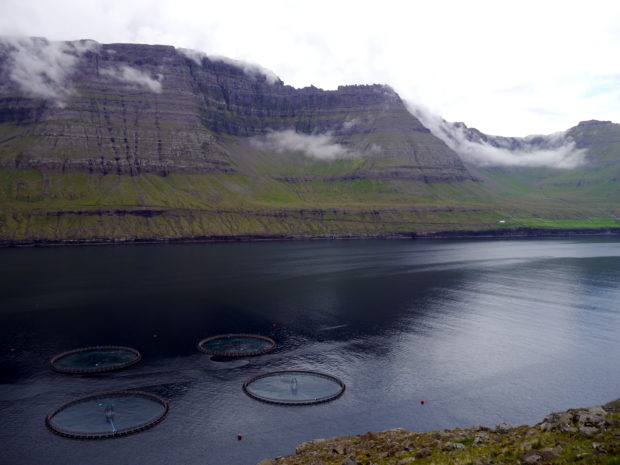Civil Eats | July 6, 2016
Wild seafood is disappearing rapidly and many consumers have turned to farmed fish as a way to help reverse the trend. But finding a sustainable source of food for carnivorous fish such as salmon and tuna—which rank as the second and third most popular types of seafood in America—has been a persistent challenge for aquaculture producers.
Now, a group of scientists have developed a new form of fish feed that uses no agricultural land and requires very little water. It’s called FeedKind and it’s made from bacteria that eats methane and turns it into energy.
This approach is promising because for a long time fish farms merely fed these fish a diet consisting of wild “forage” fish and oil derived from wild fish. But it often took several pounds of wild fish to produce 1 pound of farmed fish, making it a loss for the oceans.
Then, in recent years, the aquaculture industry turned to feed based on corn, soy, and wheat, usually using dried distiller grains. While these solutions are often better for the oceans, they also rely heavily on agricultural land, much in the way other animal feed does. Similarly, they rely on the use of pesticides and synthetic nitrogen fertilizer, which contribute to “dead zones” in the ocean.
“We’re taking carbon from outside the food chain, which frees up more food for humans,” says Josh Silverman, the founder and chief products officer of Calysta, a biotech startup in Silicon Valley. “And we’re turning methane into a higher value product.”
Calysta says FeedKind could address sustainability problems plaguing aquaculture, which the Food and Agricultural Organization found is one of the fastest-growing agricultural industries worldwide.
After raking in $30 million of capital from investors in a third round of funding—including animal feed giant Cargill—since December, Calysta is readying a R&D plant in England that plans to manufacture FeedKind at pilot scale by the end of this year. It’s also hoping to get a North American commercial production facility online by 2018.
FeedKind is made by first dissolving methane in water with the bacteria (methanotrophs that are commonly found in the top layer of soil). The bacteria gobbles up the methane molecules. Then, after the mixture is fermented, the protein produced from this process is extruded and formed into pellets.
“[People] have known about this bacteria for years,” says Silverman, who has a Stanford PhD in biotechnology and comes from the biopharmaceutical industry. “But no one had thought about how to use them in industrial applications.”
The alternative fish feed was originally developed over a decade ago by Norferm, a Norwegian company that won approval to sell FeedKind in the European Union. After Calysta acquired the company in 2014, Silverman says he refined the fermenting process.
Norferm only tested the product in salmon. But Silverman claims that FeedKind could also be used to feed other carnivorous fish such as halibut, sea bass, sea bream, eel, and shrimp—perhaps even terrestrial livestock and pigs, he adds.
Jan Brekke, the CEO of Sogn Aqua, a sustainable halibut farm in Norway, says he has not tested FeedKind on his fish, but is encouraged by its potential.
“The whole idea of [not] using biomass from the sea to produce fishmeal will turn global fish farming in a total different direction,” he said in an email.
FeedKind is not an environmentally pristine product. For one thing, carbon dioxide is released into the atmosphere during the fermenting process. And Silverman says that Calysta plans to source the methane for FeedKind from natural gas extracted from the electricity grid rather than capturing it from the atmosphere. (Methane is a significant component of natural gas).
Still, Carbon Trust, a London-based consulting firm, found that producing FeedKind consumed 76 percent less water than growing the same amount of protein found in soybean meal and 98 percent less water than wheat gluten. (Calysta sponsored the research, but Carbon Trust maintains that its conclusions were developed independently and the study was peer reviewed.)
Sourcing methane from the grid rather than capturing the emissions produced from human activities (such as fossil fuel production, livestock farming and decomposing landfill waste) may seem like a huge missed opportunity, considering that the greenhouse gas is over 25 times more potent than carbon dioxide.
But because natural gas is so inexpensive, Silverman says there’s no significant infrastructure or market incentive in place for his company to capture methane at commercial scale.
Still, Jillian Fry, the director of the Public Health & Sustainable Aquaculture Project at Johns Hopkins University’s Center for a Livable Future, points out that the Carbon Trust study doesn’t take into account the large environmental impact associated with fracking, a process which is responsible for two-thirds of the natural gas produced in the U.S., according to the federal government.
“It’s a glaring gap,” she says. “Even if not 100 percent [of the natural gas and methane] comes from fracking, the water, land use, and the pollution need to be taken into account,” she says.
Silverman is hoping that commercializing FeedKind will help to stimulate further the unmet demand to convert methane into something more useful—and help to build the infrastructure Calysta needs to source methane more sustainably in the future.
Fry adds that because of the carbon dioxide that’s released and the methane sourcing, it’s difficult to say at this stage if FeedKind is something everyone should throw their support behind.
But she still thinks it has promise. “We need to strike a balance—we don’t want to kill all enthusiasm for a new product and say that there’s no progress unless it’s flawless,” she says. “It’s very exciting to hear about this kind of development.”
—
Note: This story was reprinted in GreenBiz on August 16, 2016.

